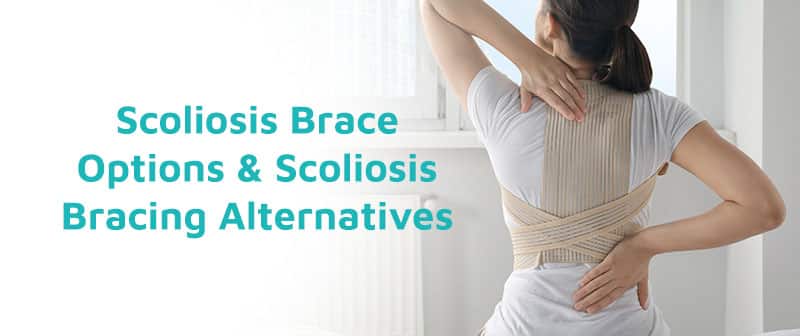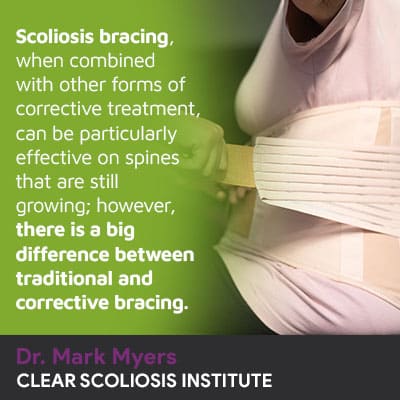
There are different scoliosis brace options available, and it’s important to understand the difference between traditional bracing and corrective bracing. The former only addresses the condition as 2-dimensional, which is problematic, because scoliosis is a complex 3-dimensional spinal condition; corrective bracing addresses it as such so can help work towards actually correcting a scoliotic curve.
Just as there are different scoliosis treatment approaches for patients to choose between, there are different types of braces that offer different results; only corrective bracing can help augment corrective results achieved through other proactive treatment disciplines.
Before getting to the specific differences between traditional and corrective bracing, let’s first define scoliosis and explain how it’s diagnosed.
In order to reach a diagnosis of scoliosis, certain condition characteristics have to be present.
Scoliosis is the development of an unnatural sideways spinal curve, and in order to be considered a true scoliosis, the scoliotic curve has to have a rotational component.
It’s the rotation that makes scoliosis a 3-dimensional condition because the unhealthy spinal curve doesn’t just bend unnaturally to the side, but also twists.
Any type of treatment that doesn’t address scoliosis as 3-dimensional is going to be limited in its efficacy because it won’t impact the condition on every level.
In addition, a scoliotic curve has to be of a certain size to be diagnosed as scoliosis, and this is based on a measurement known as Cobb angle.
When a spine has its healthy and natural curves in place, its vertebrae (bones) are aligned; if an unhealthy spinal curve develops, the vertebrae at the curve’s apex are tilted unnaturally, causing a misaligned spine.
A misaligned spine is contrary to its design and won’t be as strong, flexible, or as able to handle mechanical stress during movement/activity.
The higher a patient’s Cobb angle, the more severe their condition is, ranging from mild to severe.
It’s also important to understand the condition’s progressive nature.
Scoliosis is a structural progressive spinal condition, meaning that it’s virtually guaranteed to get worse because it’s in its nature to do so, especially if severe and/or if left untreated.
Scoliosis progressing means the unnatural spinal curve is getting larger, and as this happens, the body is being exposed to more and more uneven forces, and the effects of those uneven forces are also going to increase and become more noticeable.
In addition, as a scoliotic curve gets larger, the spine becomes more rigid, making it less responsive to chiropractic treatment and more complex to treat.
As it’s also the spine’s surrounding muscles that help maintain the healthy spinal curves by supporting the spine, those muscles are also affected by the condition’s uneven forces and can develop an imbalance.
The muscles on one side of the spine can become tight, stretched, and sore from overuse, while the muscles on the opposite side can become weak from underuse.
While I can never give treatment guarantees, early detection and intervention can have significant benefits in terms of treatment efficacy, particularly in young patients who have not yet reached skeletal maturity; growth is the trigger for scoliosis progression.
Speaking of patient age, as there are multiple types of scoliosis determined by their underlying cause, let’s focus on the most prevalent form: adolescent idiopathic scoliosis (AIS), affecting adolescents between the ages of 10 and 18.

Traditional Scoliosis Brace Options
There are two main scoliosis treatment approaches for patients to choose between, and each approach has a different end goal and uses a different type of brace that’s aligned with that goal.
Traditional scoliosis treatment commonly funnels patients towards spinal fusion surgery, and this is because it doesn’t have a strategy for addressing scoliosis while still in the mild condition, so it doesn’t work towards preventing progression, but rather responds to progression once it’s reached a certain level.
Once a patient’s Cobb angle is 40+ degrees, this is considered severe scoliosis, and if a patient undergoing traditional treatment becomes severe and shows signs of further progression, they become surgical candidates.
The only form of treatment applied prior to surgery is traditional bracing, commonly started in the moderate level of progression.
While there are different types of traditional braces, the most commonly-used traditional scoliosis brace is the boston brace, and this is associated with a number of cons, the main one being that it only addresses scoliosis as a 2-dimensional condition, ignoring its 3-dimensional nature.
The boston brace is mass produced, so not customized to suit a patient’s individual body/curvature type: causing compliance issues as these braces are uncomfortable to wear and often have to be worn full time.
If a brace isn’t worn precisely as prescribed, potential efficacy is further limited.
The boston brace is not corrective because its goal is not to correct the curve, but to stop it from progressing; it does so by applying pressure to the curve at certain points and squeezing it into a straighter position.
This squeezing, however, can actually weaken the spine over time, leading to other issues.
So the main reason why traditional bracing doesn’t work is because it’s part of traditional treatment that isn’t proactive, and doesn’t address the condition’s 3-dimensional nature.
Traditional scoliosis treatment doesn’t respond to a diagnosis proactively by starting treatment immediately following a diagnosis, and traditional bracing hasn’t evolved to reflect our growing understanding of the condition.
Corrective Bracing Options
The other main scoliosis treatment approach is conservative, and as a CLEAR-certified scoliosis chiropractor, this is how my patients are treated.
Conservative chiropractic-centered treatment does want to manage progression, but it does so through being proactive and preventing progression by working towards achieving a curvature reduction.
When combined with other forms of condition-specific treatment such as chiropractic care and physical therapy, corrective bracing can be a highly-effective facet of treatment.
The ScoliBrace is an ultra-corrective scoliosis brace that addresses many of the shortcomings of the traditional boston by:
In addition, the main symptom of scoliosis in adolescents is postural deviation such as uneven shoulders, hips, and the development of a rib arch, and traditional bracing can actually worsen postural deviation, while corrective bracing, as it’s helping to correct a scoliosis, can actually improve postural deviation.
While bracing can help augment corrective results achieved through other treatment disciplines, no brace on its own is enough to correct a scoliosis.
Correcting scoliosis means reducing the curvature size on a structural level because scoliosis is a structural condition; this is worked towards through a series of chiropractic techniques and manual adjustments.
Condition-specific chiropractic care can help adjust the position of the most-tilted vertebrae so they are more aligned with the rest of the spine, improving the biomechanics of the entire spine.
Physical therapy and the use of scoliosis-specific exercises (SSEs) are applied in the interest of strengthening the muscles surrounding the spine so they can take pressure off the spine by fully supporting/stabilizing it.
Physical therapy can also help address any related muscle imbalance that might have developed and can also help improve communication between the brain and the rest of the body to improve posture and facilitate a more balanced body position.
Traditional treatment is often described as reactive because it doesn’t actively respond to a patient’s scoliosis until it reaches a certain level of severity, commonly recommending invasive spinal surgery.
The only form of treatment applied prior to receiving a surgical recommendation is traditional bracing, which as discussed, is limited in its potential efficacy.
The boston brace is the most common brace used in traditional treatment, and despite being designed in the 1970s, it has changed little over the years.
The ScoliBrace is an ultra-corrective modern scoliosis brace used in conservative treatment because correction is the ultimate goal of treatment, whereas stopping progression is the ultimate goal of traditional treatment.
Corrective bracing has evolved over the years so is aligned with our growing understanding of scoliosis and how it responds to different types of treatment.
As a progressive condition, scoliosis is incurable, but when addressed proactively, it can be highly treatable.
Here at the CLEAR Scoliosis Institute, when bracing is deemed appropriate for a patient, corrective bracing is integrated into a multi-faceted treatment plan capable of impacting a patient’s scoliosis on every level.

CLEAR provides a unique and innovative way of understanding scoliosis. Sign up to receive facts and information you won’t find anywhere else.
